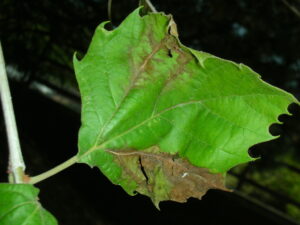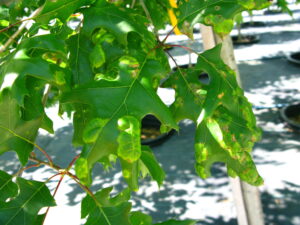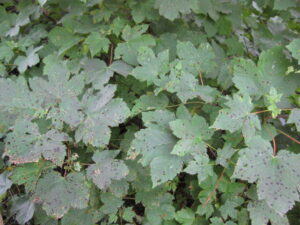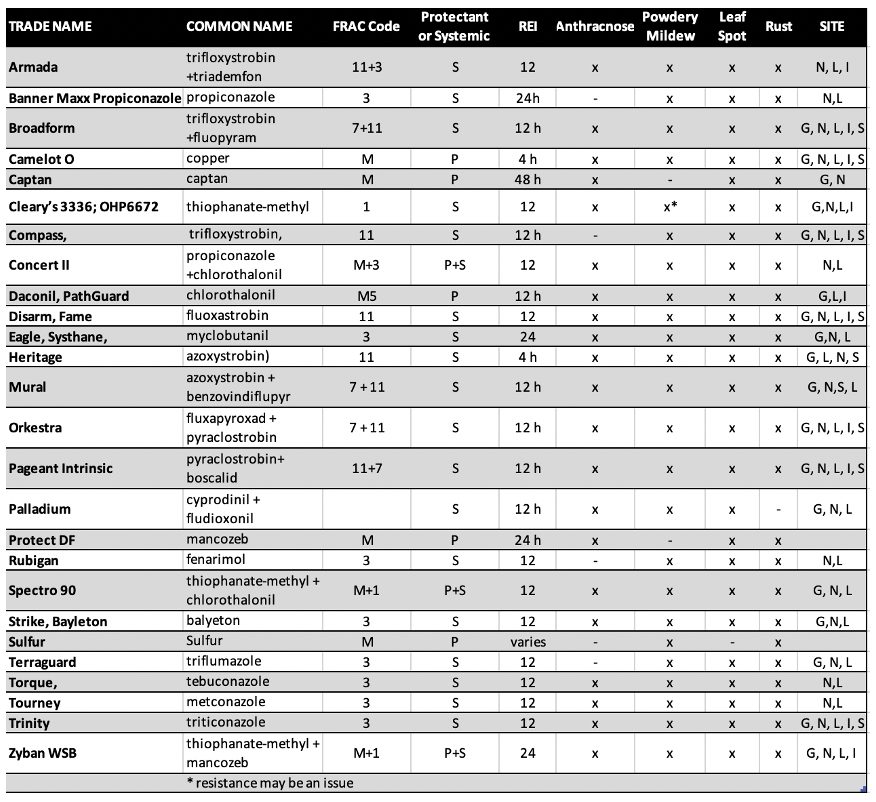While fungi are responsible for many of our foliar disease problems, different fungal pathogens present as problems throughout the country, depending upon the host plant grown and the environmental conditions. This is a brief overview of several common types of fungal leaf diseases occur in Indiana and throughout North America (and Europe). Recognizing the symptoms and signs is an important first step to diagnose a disease problem, followed by how to manage these diseases by combining cultural and chemical controls.
Common fungal leaf diseases of deciduous trees and shrubs
Anthracnose. Anthracnose diseases probably are the best-known foliar fungal diseases of deciduous trees. They affect many ornamental trees including major shade-tree genera such as sycamore (Platanus spp.), oak (Quercus spp.), maple (Acer spp.), elm (Ulmus spp.) and ash (Fraxinus spp.) (Fig. 1). Anthracnose actually is a general term describing symptoms such as dead irregular areas that form along and between the main vein of the leaf. The leaves may also become curled and distorted and twigs may die back. The fungus overwinters in infected twigs and the petioles of fallen leaves, and the spores disseminate in the spring by wind and splashing rain. The disease, while unsightly, rarely results in the tree’s death. Sycamores and other trees often withstand many years of partial defoliation. However, one anthracnose disease is more serious. Dogwood anthracnose (Discula destructiva) is a devastating problem on the Eastern seaboard, but has not been a significant issue here in Indiana.
Leaf blisters result in the blistering, curling and puckering of leaf tissue. Oak leaf blister (Taphrina caerulescens) is a common blister disease of oaks (Fig. 2)., particularly the red oak subgenus, which includes Northern red oak (Q. rubra) and pin oak (Q. palustris) among others. The symptoms begin as a slight yellowing of the infected leaf followed by round, raised blisters. These turn brown, and the infected leaves fall prematurely. This fungus overwinters as spores on the buds.
Leaf spot is a general symptom caused by a multitude of pathogens and infect all deciduous trees and shrubs, and include dead spots with a defined boundary between living and dead tissue. The dead tissue often separates from the surrounding living tissue creating a “shot-hole” appearance on the infected leaves. Common hosts include dogwood, maples, hydrangea, rose, holly, and Indian-hawthorn.
Tar spot (Rhytisma spp.) is a leaf disease with initial symptoms similar to leaf spot. The disease is most common on red (Acer rubrum) and silver maple (A. saccharinum) (Fig.3), but it can occur on a wide range of maple species from sugar (A. saccharum) and Norway (A. platanoides) to bigleaf maple (A. macrophyllum). The symptoms begin in the spring as small greenish-yellow spots on the upper leaf surface that, by mid-summer, progress to black tar-like spots about 0.5 inch in size. The disease is not fatal to the tree, but the appearance of the tar spots alarms some tree owners. A major outbreak in New York about 10 years ago left many maples completely defoliated by mid-August.
Powdery mildew fungi infect most species of deciduous woody plants. The typical symptoms of this disease are small dusty-white or gray patches that develop by mid-summer. These patches continue to enlarge during the summer, and the entire leaf may eventually appear white. By late summer, tiny brown to black fruiting structures usually develop in these patches. The disease overwinters on the fallen leaves or as mycelium in infected buds. In spring, the fruiting structures release wind- and rain-dispersed spores from the leaves. This fungus grows best in warm, moist conditions. The mycelium, unlike most other foliar diseases, grows on the surface of the leaves rather than within the leaf. Infected leaves may have less photosynthetic capability, but the problem is generally aesthetic. Although this disease rarely results in sufficient injury to warrant treatments, its high visibility is a frequent cause of concern to tree and shrub owners.
Rusts are unusual fungi in that they may require two unrelated hosts to complete their life cycle. Rust fungi produce fruiting bodies on host species “A,”(think juniper) which releases spores that only infect host species “B”(rose family, like crabapple, hawthorn or serviceberry). The fungi in “B” produces spores that only infect “A,” and the cycle repeats. The fungi do cause some injury in both hosts, but often only one of the two species has any ornamental value. The rust disease that affects an ornamental tree may have an alternate host that is just an incidental plant in the landscape, or even a crop or a weed. Removal of the alternate host also is common recommendation for a rust that affects one of our most popular flowering trees, the crabapple (Malus spp.). However, here again, it generally proves to be impractical. Juniper rust (Gymnosporangium spp.) is a problem familiar to most people that have a hawthorn, serviceberry or crabapple in their yard. Although many tree owners are aware that the disease must spend part of its life on cedar, to break the cycle you would not only need to remove the redcedars in your yard but also all those within a radius of up to a mile-obviously an impractical task.
Sooty mold is a common concern to tree owners but it is not an infectious disease. The black soot that appears on leaves is a fungus that lives on the honeydew secreted by aphid and scale insects. The fungus does not live in the leaf, it lives on it. Any other symptoms such as yellowing or curling leaves are due to the insects that produce the honeydew, not the mold. While heavy levels of sooty mold can block enough light to reduce photosynthesis by up to 70 percent, this primarily is an aesthetic problem
Foliar diseases of conifers
Foliage problems on conifers are more serious than on deciduous trees. Conifers cannot refoliate during the same season so the impact can be great. And unlike deciduous trees, the needles are important sites of food reserves for conifers. Fortunately, most foliar diseases infect either the older needles or the new ones, so some foliage remains, and the trees rarely die from these diseases. However, an infected tree can look so bad that you may hope that it dies! Needle diseases are of three types: needle cast, needle blight and needle rust.
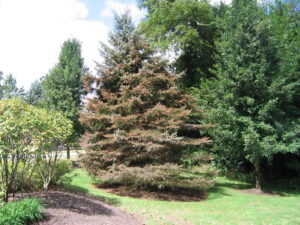
Figure 4. Rhizosphaera is a perennial problem whenever blue spruce is grown East of the Mississippi. Photo by Janna Beckerman.
Needle casts are a common problem with many conifers throughout the country (Fig. 4). These diseases affect only the needles on newly formed shoots, but the symptoms are not evident until the following spring. The infected needles develop spots that turn tan to reddish-brown. The fungal fruiting structures emerge on these needles and are usually large enough to be visible to the eye. Rhizosphaera needle cast (Rhizosphaera kalkhoffii) is probably one of the most common cast diseases because it infects one of the most ubiquitous trees in the landscape, Colorado blue spruce (Picea pungens). A season after infection, the needles turn reddish brown to purple, with the fruiting structures appearing as rows of small dots running lengthwise along the needles. These infected needles are cast (dropped) in the fall. Trees infected with this disease for many years may only have the current year’s needles remaining rather than the 5- to 8-year complement of needles a healthy spruce maintains.
Diplodia blight (Diplodia pinea), also called Sphaeropsis twig blight, is one of the most common needle blights, though it is more damaging as a shoot blight. It infects the young, succulent shoots and needles on two-and three-needled pines with Austrian pine (Pinus nigra), ponderosa pine (P. ponderosa) and Scots pine (P. sylvestris) being the most susceptible. This disease typically does not show up until the trees reach maturity. Infected trees have stunted, twisted candle growth with the expanding needles becoming straw-colored and then brown. Diplodia twig blight produces small black fruiting structures on the cone scales and at the base of the infected needles.
Cultural control measures for common foliar diseases
Foliage must remain wet for a period of several hours or more for spores to germinate, so persistently cool, moist weather is ideal for fungal disease development. While you can do nothing about the weather, irrigating in the evening and maintaining overly dense plantings can achieve the same environmental conditions that favor disease. Therefore, focus on improving air circulation. Improve water management by irrigating in the morning so plants may dry completely. Pruning can allow for better air circulation, while removing dead, infected twigs that may serve as a source of infection in the spring. However, in most instances, pruning is more cosmetic than disease control.
Raking fallen leaves is a common recommendation for removing the primary source of next year’s infections. While this may be effective in certain instances, it is nearly impossible to eliminate all the infected leaves from a property, let alone the fallen leaves from adjacent properties. In addition, many fungal leaf diseases overwinter in the buds, twigs and cones remaining in the tree, so raking may have a minimal effect on the level of spore production. It helps, but it shouldn’t be confused with ‘curing’ the problem.
Are chemical treatments needed?
Fungal leaf diseases generally do not require chemical treatments because they usually are not life-threatening. Here are some of the questions you should consider before deciding to apply a treatment.
- Have you correctly identified the pathogen?
- Has the tree or shrub lost more than half its foliage more than three times in the last five years?
- Has the tree or shrub recently experienced additional stress from other pests, pathogens or disorders?
- Is the disease life-threatening to the tree?
- Is the host tree so valuable or visible that the loss of some foliage will concern the client?
- Is the client aware that several treatments may be necessary this growing season and that the disease may come back again next year?
If you answered “no” to any of these questions, obtain additional information prior to beginning any chemical management options.
Chemical treatments for common fungus problems
Fungicides are commonly used to control fungal foliar diseases problems (see the Table 1). Successful use of fungicides require maintaining a chemical barrier between the leaf and the fungus, which means repeated applications at fixed intervals-usually 7 to 14 days-beginning with bud break for deciduous trees or budbreak AND the formation of the candle for conifers. You typically need to make three applications, though more may be necessary if cool, moist conditions persist into the summer. Some foliar diseases, like rose blackspot, may require season-long applications of fungicides.
Fungal leaf diseases are a challenge to identify and manage. Avoid the temptation to quickly reach for the sprayer at the first appearance of leaf symptoms. First, identify the agent or agents responsible for the symptoms. Then, if it is a fungal leaf disease, determine the potential damage to the plant’s health and appearance. And finally, remember that it’s too late to do much right now, but it’s just about right to begin planning for spring treatments next year.
Table 1. List of registered fungicides and target diseases. Be sure to review the label on the fungicide you are using for rates and specific disease management guidelines.
